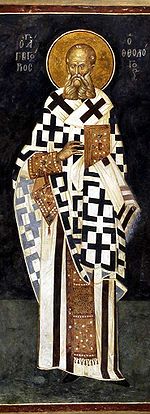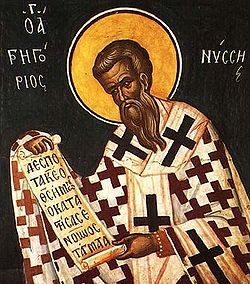
Cappadocian Fathers
Encyclopedia


Gregory of Nyssa
St. Gregory of Nyssa was a Christian bishop and saint. He was a younger brother of Basil the Great and a good friend of Gregory of Nazianzus. His significance has long been recognized in the Eastern Orthodox, Oriental Orthodox, Eastern Catholic and Roman Catholic branches of Christianity...
(c.330-395), who was bishop of Nyssa
Nyssa (Cappadocia)
Nyssa was a Roman/late-Roman town of Cappadocia. It is located near to the modern town of Harmandalı, Ortaköy district, Aksaray province, in south-central Turkey....
; and a close friend, Gregory of Nazianzus
Gregory of Nazianzus
Gregory of Nazianzus was a 4th-century Archbishop of Constantinople. He is widely considered the most accomplished rhetorical stylist of the patristic age...
(329-389), who became Patriarch of Constantinople
Patriarch of Constantinople
The Ecumenical Patriarch is the Archbishop of Constantinople – New Rome – ranking as primus inter pares in the Eastern Orthodox communion, which is seen by followers as the One, Holy, Catholic, and Apostolic Church....
. The Cappadocia
Cappadocia
Cappadocia is a historical region in Central Anatolia, largely in Nevşehir Province.In the time of Herodotus, the Cappadocians were reported as occupying the whole region from Mount Taurus to the vicinity of the Euxine...
region, in modern-day Turkey
Turkey
Turkey , known officially as the Republic of Turkey , is a Eurasian country located in Western Asia and in East Thrace in Southeastern Europe...
, was an early site of Christian activity, with several missions by Paul
Paul of Tarsus
Paul the Apostle , also known as Saul of Tarsus, is described in the Christian New Testament as one of the most influential early Christian missionaries, with the writings ascribed to him by the church forming a considerable portion of the New Testament...
in this region.
The Cappadocian Fathers advanced the development of early Christian theology
Christian theology
- Divisions of Christian theology :There are many methods of categorizing different approaches to Christian theology. For a historical analysis, see the main article on the History of Christian theology.- Sub-disciplines :...
, for example the doctrine of the Trinity
Trinity
The Christian doctrine of the Trinity defines God as three divine persons : the Father, the Son , and the Holy Spirit. The three persons are distinct yet coexist in unity, and are co-equal, co-eternal and consubstantial . Put another way, the three persons of the Trinity are of one being...
, and are highly respected as saints in both Western
Western Christianity
Western Christianity is a term used to include the Latin Rite of the Catholic Church and groups historically derivative thereof, including the churches of the Anglican and Protestant traditions, which share common attributes that can be traced back to their medieval heritage...
and Eastern
Eastern Christianity
Eastern Christianity comprises the Christian traditions and churches that developed in the Balkans, Eastern Europe, Asia Minor, the Middle East, Northeastern Africa, India and parts of the Far East over several centuries of religious antiquity. The term is generally used in Western Christianity to...
churches.
Biographical background
An older sister of Basil and Gregory of Nyssa, MakrinaSaint Macrina the Younger
Saint Macrina the Younger was born at Caesarea, Cappadocia. Her parents were Basil the Elder and Emmelia, and her grandmother was Saint Macrina the Elder. Among her nine siblings were two of the three Cappadocian Fathers, her younger brothers Basil the Great and Saint Gregory of Nyssa, as well as...
, became a nun and converted the family's estate into a monastic community. Abbess Makrina there fostered the education and development of the three Cappadocians by providing a peaceful shelter for study and meditation. Basil the Great was the second oldest of Makrina's brothers, the eldest being the famous Christian jurist Naucratius
Naucratius
Saint Naucratius was the son of Basil the Elder and Emmelia of Caesarea. He had distinguished himself both in scholarship and Christian devotion, as an active hermit, a living example for his famous brothers, Basil and Gregory of Nyssa.-Life:...
.

Theological contributions
The three scholars set out to demonstrate that Christians could hold their own in conversations with learned Greek-speaking intellectuals and that Christian faith, while it was against many of the ideas of Plato and Aristotle (and other Greek Philosophers), was an almost scientific and distinctive movement with the healing of the soul of man and his union with God at its center - one best represented by monasticism. They made major contributions to the definition of the TrinityTrinity
The Christian doctrine of the Trinity defines God as three divine persons : the Father, the Son , and the Holy Spirit. The three persons are distinct yet coexist in unity, and are co-equal, co-eternal and consubstantial . Put another way, the three persons of the Trinity are of one being...
finalized at the First Council of Constantinople
First Council of Constantinople
The First Council of Constantinople is recognized as the Second Ecumenical Council by the Assyrian Church of the East, the Oriental Orthodox, the Eastern Orthodox, the Roman Catholics, the Old Catholics, and a number of other Western Christian groups. It was the first Ecumenical Council held in...
in 381 and the final version of the Nicene Creed
Nicene Creed
The Nicene Creed is the creed or profession of faith that is most widely used in Christian liturgy. It is called Nicene because, in its original form, it was adopted in the city of Nicaea by the first ecumenical council, which met there in the year 325.The Nicene Creed has been normative to the...
, finalised there.
They made key contributions to the doctrine of the Trinity and to the responses to Arianism
Arianism
Arianism is the theological teaching attributed to Arius , a Christian presbyter from Alexandria, Egypt, concerning the relationship of the entities of the Trinity and the precise nature of the Son of God as being a subordinate entity to God the Father...
, Apollinarianism, and the filioque debate.
Subsequent to the First Council of Nicea, Arianism
Arianism
Arianism is the theological teaching attributed to Arius , a Christian presbyter from Alexandria, Egypt, concerning the relationship of the entities of the Trinity and the precise nature of the Son of God as being a subordinate entity to God the Father...
did not simply disappear. The semi-Arians taught that the Son is of like substance with the Father (homoiousios) as against the outright Arians who taught that the Son was not like the Father. So the Son was held to be like the Father but not of the same essence as the Father.
The Cappadocians worked to bring these semi-Arians back to the orthodox cause. In their writings they made extensive use of the (now orthodox) formula "one substance (ousia
Ousia
Ousia is the Ancient Greek noun formed on the feminine present participle of ; it is analogous to the English participle being, and the modern philosophy adjectival ontic...
) in three persons (hypostaseis)". The relationship is understandable, argued Basil of Caesarea, in a parallel drawn from Platonism
Platonism
Platonism is the philosophy of Plato or the name of other philosophical systems considered closely derived from it. In a narrower sense the term might indicate the doctrine of Platonic realism...
: any three human beings are each individual persons and all share a common universal, their humanity. The formulation explicitly acknowledged a distinction between the Father, the Son and the Holy Spirit, (a distinction that Nicea had been accused of blurring), but at the same time insisting on their essential unity.
Thus Basil wrote:
"In a brief statement, I shall say that essence (ousia) is related to substance (hypostasis) as the general to the particular. Each one of us partakes of existence because he shares in ousia while because of his individual properties he is A or B. So, in the case in question, ousia refers to the general conception, like goodness, godhead, or such notions, while hypostasis is observed in the special properties of fatherhood, sonship, and sanctifying power. If then they speak of persons without hypostasis they are talking nonsense, ex hypothesi; but if they admit that the person exists in real hypostasis, as they do acknowledge, let them so number them as to preserve the principles of the homoousion in the unity of the godhead, and proclaim their reverent acknowledgment of Father, Son, and Holy Spirit, in the complete and perfect hypostasis of each person so named."
—Epistle 214.4.
Basil thus attempted to do justice to the doctrinal definitions of Nicea while at the same time distinguishing the Nicene position from modalism, which had been Arius
Arius
Arius was a Christian presbyter in Alexandria, Egypt of Libyan origins. His teachings about the nature of the Godhead, which emphasized the Father's divinity over the Son , and his opposition to the Athanasian or Trinitarian Christology, made him a controversial figure in the First Council of...
's original charge against Pope Alexander in the Nicene controversy. The outcome was that Arianism and semi-Arianism virtually disappeared from the church.
While the Cappadocians shared many traits, each one exhibited particular strengths. Scholars note that Basil was "the man of action", Gregory of Nazianzus "the orator" and Gregory of Nyssa "the thinker".
See also
Cappadocian Fathers- Basil of CaesareaBasil of CaesareaBasil of Caesarea, also called Saint Basil the Great, was the bishop of Caesarea Mazaca in Cappadocia, Asia Minor . He was an influential 4th century Christian theologian...
- Gregory of NazianzusGregory of NazianzusGregory of Nazianzus was a 4th-century Archbishop of Constantinople. He is widely considered the most accomplished rhetorical stylist of the patristic age...
- Gregory of NyssaGregory of NyssaSt. Gregory of Nyssa was a Christian bishop and saint. He was a younger brother of Basil the Great and a good friend of Gregory of Nazianzus. His significance has long been recognized in the Eastern Orthodox, Oriental Orthodox, Eastern Catholic and Roman Catholic branches of Christianity...
others
- Peter of SebastePeter of SebastePeter of Sebaste was a bishop, taking his usual name from the city of his bishopry, Sebaste in Armenia.Also known as Peter of Sebasteia....
- Three Holy HierarchsThree Holy HierarchsThe Three Holy Hierarchs of Eastern Christianity refers to Basil the Great , Gregory the Theologian and John Chrysostom. They were highly influential bishops of the early church who played pivotal roles in shaping Christian theology...
: Basil of Caesarea, Gregory of Nazianzus and John Chrysostom.

